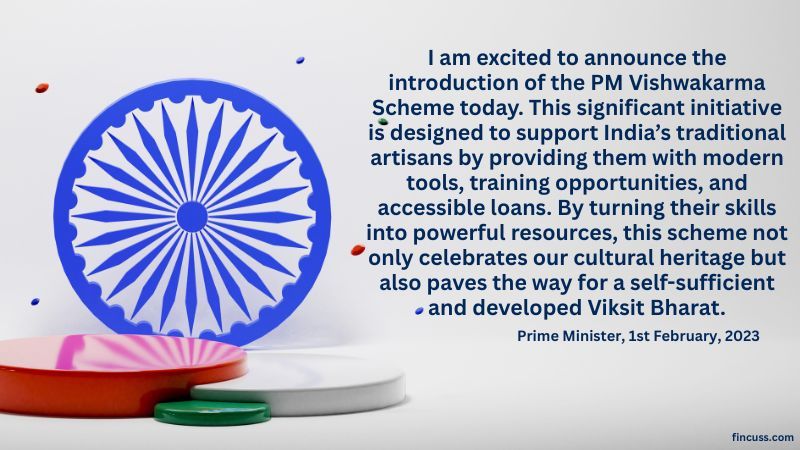Turning Skill into Success: How the PM Vishwakarma Scheme is Financing New Entrepreneurs
-
The PM Vishwakarma Yojana, launched on September 17, 2023, recognizes and uplifts traditional artisans. This transformative scheme emphasizes the dignity of craftspeople, providing not just financial aid but also support for those in the unorganized sector. It coincides with Vishwakarma Day, highlighting the importance of these skilled workers.
The philosophy focuses on honoring traditional skills, especially through the guru-shishya model, while preparing workers for contemporary success.

Understanding the Scheme’s Core Mission
The PM Vishwakarma Yojana allocates ₹13,000 crores from FY 2023-24 to FY 2027-28 to support artisans. It focuses on providing recognition, training, credit access, and market linkages for skilled workers.
- Joint implementation by MoMSME, MSDE, and DFS.
- Focus on empowering marginalized groups.
- Target groups include Scheduled Castes, Scheduled Tribes, OBCs, and women.
Who Benefits? The Traditional Trades Covered
The scheme aims to support around 3 million artisans and craftsmen in India, both rural and urban. It focuses on individuals using traditional hand tools. The government has identified 18 to 19 traditional trades included in this initiative, many of which may be familiar to the public.
- Woodworkers include carpenters, boat makers, and masons, with masons being the most registered.
- Metal workers consist of blacksmiths, lock makers, and goldsmiths.
- Clay workers comprise potters, sculptors, and toy makers.
- Fabric workers include tailors, washermen, barbers, and garland makers.
- Leather workers are cobblers and basket/mat makers.
- Other trades include fishnet makers.
Eligibility at a Glance
For an artisan or craftsman to apply, certain criteria must be met to ensure that the benefits reach the intended population.
- The applicant must be an Indian resident (permanent resident).
- The minimum age is 18; some sources specify up to 60 years.
- Must be engaged in one of 18 recognized traditional trades.
- Benefits are limited to one family member (husband, wife, or unmarried children).
- The applicant must not be a government employee.
- Cannot have used a similar government credit scheme in the last five years.
Documents Required
- Required documents for registration include the Aadhaar Card, Bank Passbook, and PAN Card.
- The Age/Birth Certificate confirms the applicant's age is between 18 and 60 years.
- A passport photo, mobile number, and email ID are also necessary.
- A BPL or Ration Card, Caste Certificate, and Income Certificate are required for eligibility.
- The Residence Certificate confirms permanent residency in India.
- Identity proof and a Training Certificate for traditional trade skills are needed.
- The registration process includes Aadhaar authentication using biometrics.
- Documents must align with the specific traditional skill of the applicant.
The Pillars of Support: Transforming Lives
The scheme offers holistic support designed to enhance productivity, increase financial security, and provide dignity for the workers.
-
Recognition and Dignity
- Artisans receive PM Vishwakarma Certificates and ID Cards.
- Recognition offers dignity and acceptance for traditional trades.
- Example: Mason Prateek Prakash Rao Jamadkar illustrates this impact.
-
Skill Development and Modernization
- Skill intervention training lasts 5 to 7 days for capability upgrades.
- Trainees earn ₹500 daily as a stipend during training.
- Successful completion rewards beneficiaries with a ₹15,000 e-voucher for modern tools.
- The toolkit incentive enhances efficiency for the trainees.
-
Collateral-Free Credit Support
- Collateral-free ‘Enterprise Development Loans’ aid artisans by reducing their reliance on expensive moneylenders.
- The loan is divided into two stages, totaling up to ₹3 lakh.
- Tranche 1: ₹1 lakh loan after basic training; 18-month repayment period.
- Tranche 2: ₹2 lakh loan after the repayment of the first tranche; 30-month repayment period.
- Beneficiaries must maintain a standard loan account and ideally adopt digital transactions.
- The interest rate is fixed at 5% due to an 8% government subvention, enhancing accessibility.
-
Market Linkages and Digital Incentives
- The scheme supports Vishwakarmas in national and global competition.
- Marketing support includes quality certification, branding, and market linkages through various platforms.
- Beneficiaries receive ₹1 per digital transaction, promoting digital reform and reducing cash usage.
Getting the Loan: The Process Explained
Many beneficiaries who receive their PM Vishwakarma certificate and ID card wonder how the loan disbursement process works. Here is what you need to know:
- List Generation: A list of eligible beneficiaries who have received their certificates, ID cards, and training stipends is prepared.
- Bank Notification: This list is sent to the banks where the beneficiaries have their registered accounts.
- Contact: If your name is on this list, the bank should contact you directly (via a phone call to your registered mobile number) to discuss the loan.
- Proactive Approach: If you do not receive a call from the bank, you must visit the bank yourself and make contact to inquire about the loan.
Remember, the loan is typically provided once you have received your certificate and the training/toolkit support payment.
A Look at the Impact So Far
The scheme has demonstrated remarkable success in achieving its targets. As of 31 August 2025, the scheme has nearly reached its five-year goal, with approximately 30 lakh registered artisans and craftsmen. Here are some actual facts detailing the progress:
- Over 26 lakh beneficiaries have completed skill verification.
- About 86% of verified individuals have finished basic training.
- More than 23 lakh e-vouchers have been issued for toolkit incentives.
- Over 4.7 lakh loans have been approved, totaling ₹41,188 crore.
The scheme is truly catering to a wide base, reaching states like Karnataka, Maharashtra, Madhya Pradesh, Rajasthan, and Andhra Pradesh.
Conclusion
The PM Vishwakarma Scheme aims to uplift India's traditional workforce by enhancing skills and providing support. It connects artisans with opportunities through recognition, skill development, access to credit, and market guidance. The initiative empowers individuals such as barbers and carpenters to establish modern businesses and acquire the necessary tools. Ultimately, the scheme fosters pride and prosperity in India's heritage.
